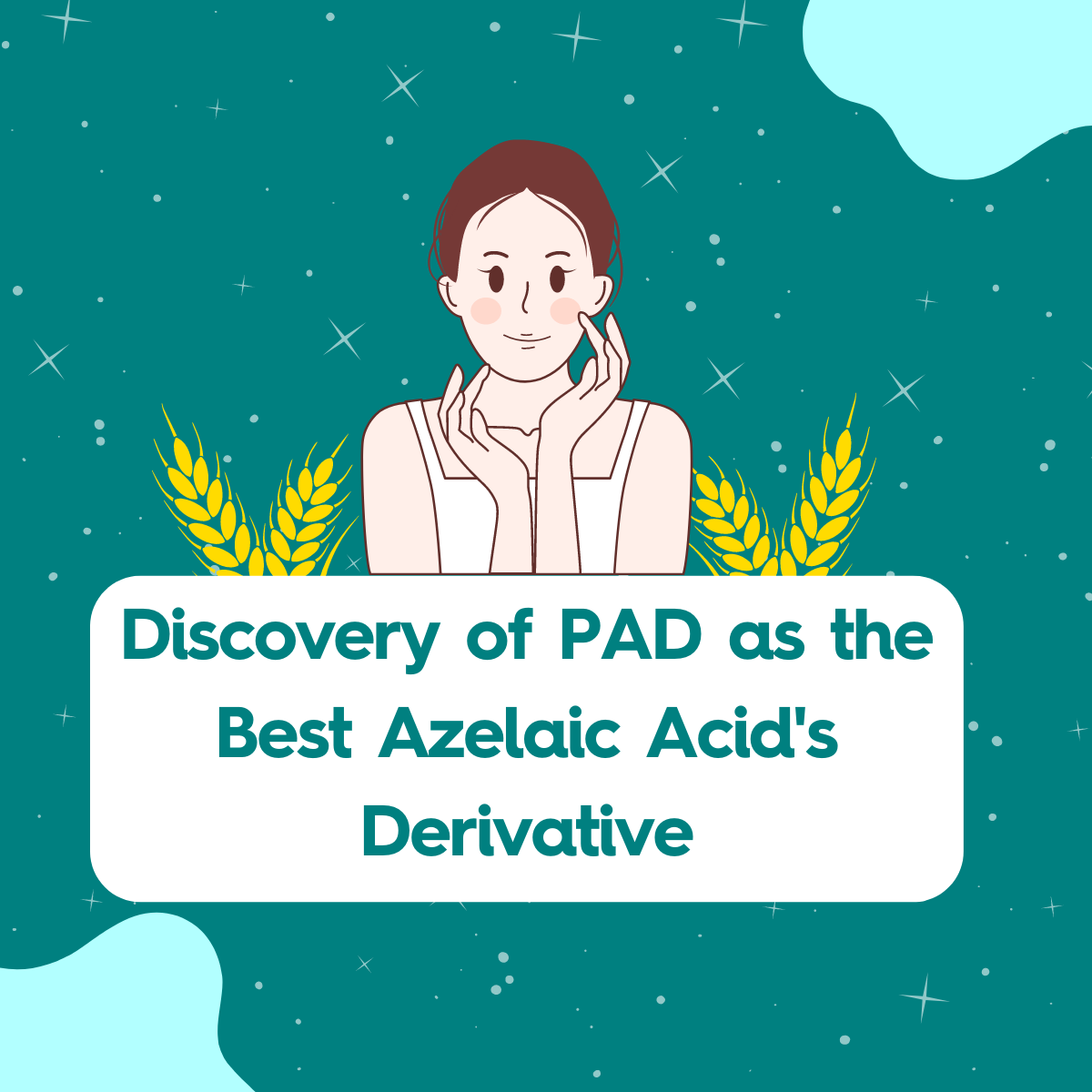Azelaic Acid has impressive studies over decades to show its great results on the skin. But we can also point to you a list of difficulties with Azelaic Acid – formulary complications, possibly unfriendly to sensitive skin, regulated as prescription active in some countries etc.
Potassium Azeloyl Diglycinate (PAD) was engineered as an attempt to counter the drawbacks of Azelaic Acid while not sacrificing its brilliant benefits.
Unlike the OG Azelaic Acid, PAD is a newcomer. Despite being a novel family addition, the arrival of PAD seems to be gaining a lot of positive responses from users.
What is Potassium Azeloyl Diglycinate (PAD)?
PAD was obtained by the reaction of the combination of three (3) compounds; the chloride of Azelaic Acid, two molecules of Glycine with the addition of Potassium Hydroxide. The Glycine component gives a hydrating and moisturizing effect while Potassium Hydroxide acts as the neutralizer of this element.

What are the differences between Potassium Azeloyl Diglycinate (PAD) and Azelaic Acid?
Azelaic Acid has a longstanding research profile, dating back to the 1980s. Usually, in form of powder as raw material, insoluble in water, chemists formulate Azelaic Acid in products with cream with a paste texture. Sensitive skin alert, its nature of low pH might not be friendly for the broken skin barrier. Therefore, due to Azelaic Acid’s high potency, it is regulated as a prescription ingredient in certain countries.
On the other hand, PAD is a modern ingredient that was newly released in the 2000s.This water-soluble ingredient is easier to be formulated in a lightweight liquid texture. It is neutral in pH. Regulated as a cosmetic ingredient in all countries, PAD is known for its gentleness. Hence, it is suitable for all skin types. However, as a newcomer, PAD requires more evidence to prove itself on par with Azelaic Acid in terms of efficacy on the skin.

The Benefits of Potassium Azeloyl Diglycinate (PAD) and its Best Concentration Based on Studies
2003 Study – 3% PAD
In 2003, 5 subjects applied an aqueous solution with 3% PAD over the face with a cotton wad. After 21 days, the researchers found that PAD had reduced the excess oil production in the T-zone by at least 27%. It also increased the stratum corneum moisture level by 12.7% at the forehead and 8.2% at the cheeks. The elasticity of the skin in the area of the forehead was also increased by 2.5%. The wrinkles were reduced by 6.7% in the area of the forehead and 9.4% in the cheeks. Lastly, it brightened overall skin tone by 3.2% of the dark spot areas and 5.4% in the normal skin areas.
2012 Study – 5% PAD
For this study, 42 volunteers with Rosacea have prescribed 5% PAD and 1% Hydroxypropyl Chitosan for 28 days. The researchers found that PAD decreased the redness on the forehead while increasing the hydration on the skin surface. Not only that, but it also reduced burning, stinging and skin flushing.
 2014 Study – 5% Pad
2014 Study – 5% Pad
This time, 30 subjects with skin prone to stinging and burning sensations were treated with 5% PAD and 1% of Hydroxypropyl Chitosan. Out of 66 total points on stinging and burning; the total score was reduced to 59 points after 4 weeks. After 8 weeks, the total score dropped to 44 points and after 12 weeks, the total score plummeted to 37 points. Thus, this research is confirming the powerful anti-inflammatory and moisturizing effects of PAD (together with Hydroxypropyl Chitosan).
Summing up from the limited and sponsored studies, with consistent use, Potassium Azeloyl Diglycinate (PAD) seems to be performing well in:-
- toning down redness from inflammation,
- reducing oiliness,
- improving the hydration of the skin as well as
- brightening the complexion.
However, PAD is still relatively new in the industry. We’re looking forward to more independent studies that could supplement the available research, further validating the efficacy of this well-rounded ingredient!
Meanwhile, if your skin couldn’t tolerate conventional Azelaic Acid, or just feel like jumping on the Azelaic Acid bandwagon, PAD is certainly the best, most interesting alternative to be added to your skincare routine.
Worthee Potassium Azeloyl Diglycinate (PAD) For You
If you are keen to add PAD into your routine, here are some of the PAD products that we would highly recommend to you.
Geek & Gorgeous aPAD 20% Azelaic Acid Derivative Serum is a water-light serum demonstrating skin-lightening, moisturizing, soothing and oil-normalizing abilities. Supercharged with safe, gentle and stable Potassium Azeloyl Diglycinate (PAD), at the highest 20% strength recommended by PAD supplier, this pioneering, high-strength PAD serum also controls sebum secretion and helps eliminate redness, for an overall glowing, balanced and calmed skin. Formulated for all skin types, especially those keen on trying the results of PAD.

Garden of Wisdom Azelaic Acid is formulated with 12% PAD, alongside soothing Allantoin and plumping Hyaluronic Acid to give skin a soft, gentle and hydrated glow. Quickly absorbed, this serum simultaneously carries excellent qualities in soothing any areas of inflammation and regulating excessive oiliness. Consistent use eliminates post-inflammatory pigmentation, breakouts, age spots and freckles. It is lightweight and gentle enough for all skin types including sensitive skin, and particularly incredible for reducing spots and dullness, or for anyone whose skin couldn’t tolerate the active Azelaic Acid.

Between PAD and Azelaic Acid, which of these two ingredients appeals you more?
References
- Berardesca, E., Iorizzo, M., Abril, E., Guglielmini, G., Caserini, M., Palmieri, R., & Piérard, G. E. (2012). Clinical and instrumental assessment of the effects of a new product based on hydroxypropyl chitosan and potassium azeloyl diglycinate in the management of rosacea. Journal of cosmetic dermatology, 11(1), 37–41. https://doi.org/10.1111/j.1473-2165.2011.00598.x
- Rigano, L., & Cucchiara, M. (2003). AZELOYL-GLYCINE: A NEW ACTIVE IN SKIN DISEQUILIBRIUM. Journal of applied cosmetology, 21, 177-188.
- Veraldi, S., Raia, D. D., Schianchi, R., De Micheli, P., & Barbareschi, M. (2015). Treatment of symptoms of erythemato-telangiectatic rosacea with topical potassium azeloyl diglycinate and hydroxypropyl chitosan: Results of a sponsor-free, multicenter, open study. The Journal of dermatological treatment, 26(2), 191–192. https://doi.org/10.3109/09546634.2014.921275


